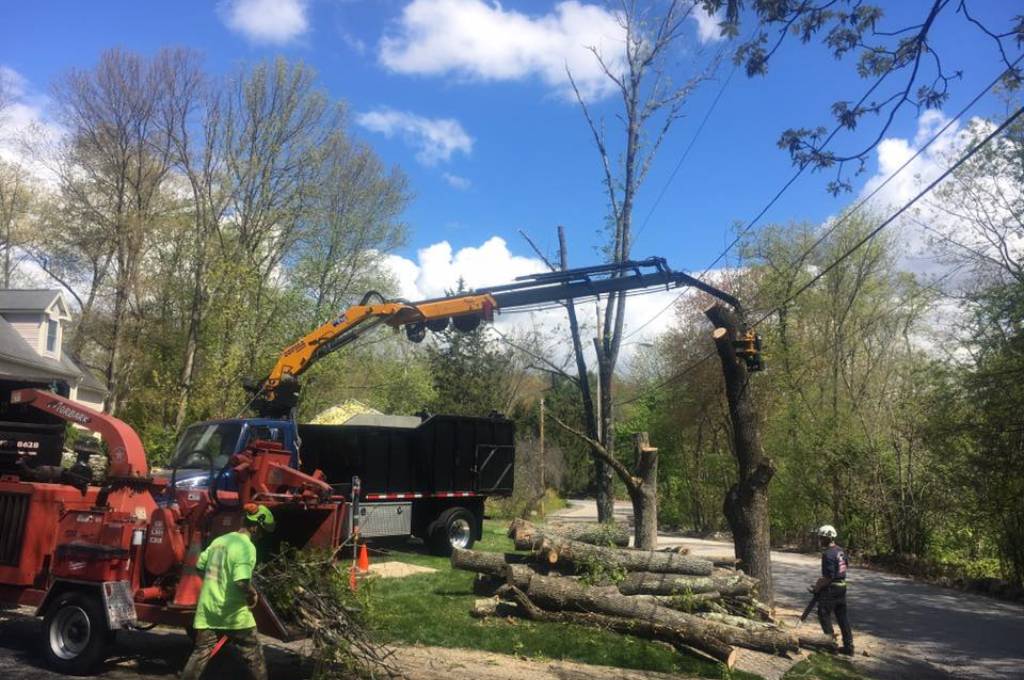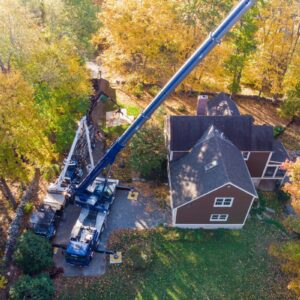Many Massachusetts homeowners love trees, especially when they’re close to our houses, since they provide shade, clean the air, and enhance curb appeal. But can a tree growing near your home be a problem that needs to be removed? And when should you remove a close tree?
In this article, you’ll discover:
- How to know if a tree is growing too close to your home – and when it might be fine where it is
- Some specific reasons you may need to cut down a tree growing near your house or another building
- The best strategy for removing a house-adjacent tree
Is My Tree Growing Too Close to My House?
“Close” is a relative term. What’s close to your house may differ from what your neighbor considers close to theirs. Or a tree you consider far away from your home will seem much closer if the tree falls over and lands on top of it.
These variables highlight why it’s necessary to evaluate the situation when it comes to a tree’s proximity to your home and whether it’s too close for comfort.

What makes a tree too close to a structure is often relative. Any tree that can come into contact with or damage your house could be considered close.
How Close is Too Close?
A tree growing near your house isn’t necessarily a bad thing. But if you think your tree may be too close to your home, there are several things to consider. Ask yourself:
Is the Tree’s Proximity to My Home Causing an Issue?
A tree growing near your house may present real problems if:
- The tree is a potential threat to your property
- The tree is potentially hazardous to people
A tree doesn’t have to fall over or drop limbs to be a threat to your property. Trees growing near structures have been known to damage roofs with their branches, break windows, pull gutters from eaves, and even rip out window-mounted air conditioners.
When it comes to people and safety, you can’t be too careful. While most trees will remain safe for their entire lives, trees growing near houses come with an additional consideration: people. Since people will spend time around your home, you want to evaluate whether or not your tree could present an unnecessary risk.
Exposed roots present a tripping hazard, and branches could fall. These factors are more likely to be a problem when a tree grows near your house because that’s where the people are!
Could Your Tree’s Proximity to the House Cause Problems in the Future?
Sometimes a nearby tree that seems fine now can grow into a big problem. Is your tree still maturing? How large do you expect it to be when it’s full-grown? You need to consider these questions when determining if your tree is too close to your house.
Developing root systems can spread out over time, potentially damaging utilities, plumbing, and concrete foundations. Limbs that aren’t a problem today could encroach on your home over time, becoming a damage risk as the tree grows. Consider the full-size size of your tree when evaluating what’s too close.
Can the Proximity Issue Be Remedied with Maintenance or Stabilization?
You have some options if you want to keep a potentially problematic tree that’s growing nearby.
If the problem with your tree is that it’s encroaching on structures or power lines, regular pruning can help to shape the tree, reduce its size, and eliminate problematic limbs. Sometimes regular tree maintenance can resolve potential issues with minimal intervention.
In the case of a structurally unstable tree, cabling and bracing may be an option to add additional support to trees growing in proximity your home. Extra support can help alleviate worry and give you the confidence to keep a tree you thought might be too close to your house.
But what about situations when removing the tree is the best option?
Reasons to Remove a House-Adjacent Tree
There are various reasons to consider cutting down a tree growing near your home. Most of the time, the reasons have to do with the tree’s health, property, and safety issues or problems caused by the tree’s roots.
If the Tree Near Your Home is Dead or Dying, It May Need to Be Removed
We recently discussed the specifics of removing dead trees in another article. In addition to being an ugly eyesore, dead trees can be dangerous, especially near your house. While not every tree showing these signs is at risk of death and needs to be removed, there are symptoms you should look for. These include:
- Broken or cracked limbs
- Decaying or hollow trunks
- Excessively peeling bark
- Dying foliage
- Sudden leaning
We should point out that while these symptoms can be due to a treatable condition, you don’t want to ignore them. Unhealthy trees will become sicker over time. Ignoring these potential issues could cost you more in the long run, so the best thing you can do if you suspect a dead, dying, or diseased tree is to have your trees assessed by a professional tree service.

Trees growing too close to power lines often must be removed because they present a safety hazard.
A Tree May Need to Be Removed if It’s Encroaching on Power Lines
A tree that’s encroaching on power lines presents a significant danger. The best-case scenario would be your tree knocks out your (and your neighbor’s) power. Worst case, your tree catches fire, becomes an electrocution hazard, or kills someone.
While some of these situations can be remedied with pruning or tree growth regulators, others require removing the tree.
Note: Pruning or removing a tree encroaching on powerlines is never a DIY job. Leave dangerous removals to the professionals!
The Tree’s Roots Might Be What’s Too Close
While a tree may not look too close to your house or other structures, its roots could be causing issues you can’t see.
Tree roots spread as they grow, potentially damaging underground utility lines and plumbing. Tree roots are even known to enter plumbing pipes through minuscule cracks and continue to grow, eventually clogging and breaking pipes.
And just like tree roots can invade small openings in pipes, they can enter small cracks in the concrete foundation of your home or other structure on your property. In these cases, the tiny roots grow and increase the size of the crack, causing significant damage to foundations.
These repairs can be costly, so consider potential root issues with your existing trees and with new trees you intend to plant.
The Best Strategy If Your Tree Needs to Be Cut Down
While close proximity tree removals can be tricky, professional tree services have specialized equipment to tackle nearly any removal and the experience to plan for efficiency and safety.
Removing a tree with a climber – in this type of removal, a tree professional will climb the tree and remove the tree piece by piece with a chainsaw. When using this method near a house, the climber will use ropes and pulleys to secure tree sections so the ground crew can gently lower them to the ground.
Crane Removal – crane removals are common when removing a tree in a confined space or near a house. Close proximity removals can be done safely and efficiently using a telescoping crane or a knuckle boom with a grapple saw. In many cases, crane removals allow the trees to be removed and lifted away in one piece.
Specific Challenges for Close Proximity Tree Removals
Removing a tree from a confined space, such as next to your home, can be tricky. Several considerations need to be made whenever a tree is removed near a house.
Access/Confined Space/Nearby Structures
Sometimes a removal location limits how close to a tree the service can place their equipment or even the type of equipment that can be used. These are situations when a crane is typically the best option since they can usually be dropped into the tight space from a distance, eliminating the need to get close.

When preparing for tree removal, planning a staging area is essential for placing equipment like the chipper truck and log truck.
Room for the Ground Crew & Staging
In addition to the space necessary for the removal, the ground crew needs room to work.
Ground crews work with sections of trees as they are removed. This work includes limbing trunks (removing branches and limbs) and bucking the trunks (sectioning) into manageable pieces.
Additional staging requirements include the necessary space to park other equipment, such as chipper trucks and log trucks. These pieces of equipment are essential to complete the removal efficiently, so their location needs to be factored into any removal job.
Meet the Challenges of House-Adjacent Tree Removals with Preparation
Once you’ve decided to remove a tree near your house, you can help the process go smoothly by preparing a few things in advance. In addition to the tips below, you can refer to our more in-depth take on preparing for your removal here.
Before your removal, you can:
- Notify your neighbors of the removal and the potential impact on their property
- Move cars from the driveway and street to free up parking for tree service vehicles
- Remove any mobile landscape elements from the area to protect them from any falling debris
Another thing you want to look into before scheduling your tree removal is to make sure the tree belongs to you and not a neighbor– you can check the Massachusetts laws on tree ownership here for the details on determining tree ownership in the state.
Additionally, if you think the tree may belong to your city or town, check your local government website to learn the proper procedure for removing these trees. If you’re a Hopkinton resident, you can contact the city tree warden here.
Need Help with a Tree Growing Near Your Home?
If you are unsure if a tree near your house is causing an issue and needs to be removed, you can request a free quote online or call us at 508-293-1193. We can inspect your tree and let you know if it can be treated if pruning can solve your issues, or if removing your tree is the best option.
American Climbers has the experience, equipment, knowledge, proper insurance, and safety qualifications to remove your trees from even the most hard-to-reach places, including right next to your house!
Blog Topics
Recent Posts
What's Happening? Stay Informed!
Stay on top of local events, pest and disease updates, tree and landscape tips, and more. Delivered straight to your inbox each month.







